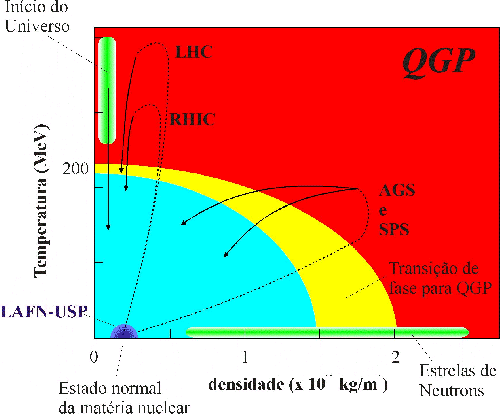Research
HEPIC (High Energy Physics Instrumentation Center) is one of the groups responsible for research in Experimental Nuclear Physics at the Physics Institute at USP. Our focus is to study different aspects of Quantum Chromodynamics* (QCD), theory developed through the 1970s that describes the strong interactions, a force that maintains the elementary particles bound within hadrons, and protons and neutrons confined inside atomic nuclei.
In particular, the group is concerned with understanding the properties of the so-called Quark-Gluon Plasma (QGP), the state of matter where quarks and gluons, constituents of protons and neutrons, are no longer confined and the interactions between particles become more complex.
The observation and characterization of such plasma, in addition to the detailed understanding of strong interactions, are also quite important from a cosmological perspective. It is believed that the Universe was in a very similar state to the QGP right after the Big Bang. In this case, the investigation of this state of matter allows a deeper comprehension of the evolution of the primordial Universe, its expansion and hadronization.

Diagram of nuclear matter phases.
The experimental investigation of the existence and characterization of this state of matter is the focus of large heavy ion accelerators at relativistic energies, such as the RHIC (Relativistic Heavy Ion Collider), in the USA, and the LHC (Large Hadron Collider), in Switzerland. With such instruments, it is possible to heat or compress nuclear matter, colliding nuclei of heavy elements, such as gold or lead, at very high energies, creating the extreme conditions necessary for the analysis of the most complex states of nuclear matter, like the QGP.

Evolution scheme of a relatvistic ion collision.
In this section, you will have access to the research done by the group related to Quantum Chromodynamics, as well as all the instrumental and computational development made to investigate the particularities of this theory.
*Quantum Chromodynamics
The QCD provides the necessary basis for the description of hadrons in terms of their fundamental constituents, the quarks. The interaction between quarks is done through gluons, which also interact with each other. This theory has proven to be quite competent in describing a wide variety of physical phenomena, from the most basic properties of atomic nuclei structure found in Nature, to situations of extreme condition, like the dynamics inside neutron stars or collisions of elementary particles in the atmosphere (cosmic rays) or inside large particle accelerators.
Two interesting characteristics of QCD, that come from the properties of the symmetry group that describes it, are the asymptotic freedom and confinement, both proved experimentally. However, one can also predict, based on this same theory, that in extreme situations of temperature and/ or baryonic density, the confinement in hadrons is no longer a necessary characteristic of the medium. In this sense, a phase transition to more complex states of matter occurs. The study of such states is extremely important for a complete understanding of the QGP state equation and its properties.
